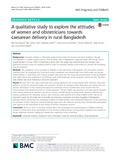A qualitative study to explore the attitudes of women and obstetricians towards caesarean delivery in rural Bangladesh

View/Open
Date
2018-09-12Publisher
BMCAuthor
Begum, TahminaEllis, Cathryn
Sarker, Malabika
Rostoker, Jean-Francois
Rahman, Aminur
Anwar, Iqbal
Reichenbach, Laura
Metadata
Show full item recordCitation
Begum, T., Ellis, C., Sarker, M., Rostoker, J.-F., Rahman, A., Anwar, I., & Reichenbach, L. (2018). A qualitative study to explore the attitudes of women and obstetricians towards caesarean delivery in rural Bangladesh. BMC Pregnancy Childbirth 18, 368 (2018). https://doi.org/10.1186/s12884-018-1993-9Abstract
Background: Caesarean section is a lifesaving surgical intervention for women and their newborns, though
overutilization is a public health concern. The caesarean rate in Bangladesh is approximately 23% overall, and in
private facilities it is over 70%. It is essential to know both the supply side (obstetricians) and demand side
(parturient women) views on caesarean birth in order to formulate specific interventions to address the escalating
rate of caesareans.
Methods: This qualitative study took place in Matlab, a rural sub-district in Bangladesh. We interviewed women
attending their 3rd antenatal visit, those with recent caesareans, and obstetricians from both public and private
health facilities. In total there were twenty in-depth interviews and four focus group discussions. Study participants
were asked about their preferences on birthing mode and knowledge of the caesarean section process. Thematic
data analysis was done following a deductive approach.
Results: Women from this rural community had a strong preference for normal vaginal birth. However, they were
willing to accept the attending health care provider’s decision for caesarean birth. Antenatal care sessions did not
provide information on the medical indications for caesarean section. Furthermore, some women had the
misconception that episiotomy itself is a ‘small caesarean.’ Primary health care providers and clinic agents (brokers)
had a strong influence on women’s decision to choose a health facility for giving birth. However, obstetricians,
having a preference for caesarean section, were receiving more patients from these brokers which may be an
important reason for the high rate of clinically non-indicated caesareans at private hospitals in Bangladesh.
Improper labour monitoring and inadequate staffing at health facilities were additional influences on the preference
for caesarean section. However, critical knowledge gaps were also observed among study obstetricians, particularly
with regards to the indications for and timing of elective caesarean sections.
Conclusion: There is a need to educate women about the advantages and disadvantages of different birthing
modes to ensure their active participation in the decision making process. Strong policy regulations are needed to
ensure legitimate decision making by obstetricians regarding mode of birthing.
